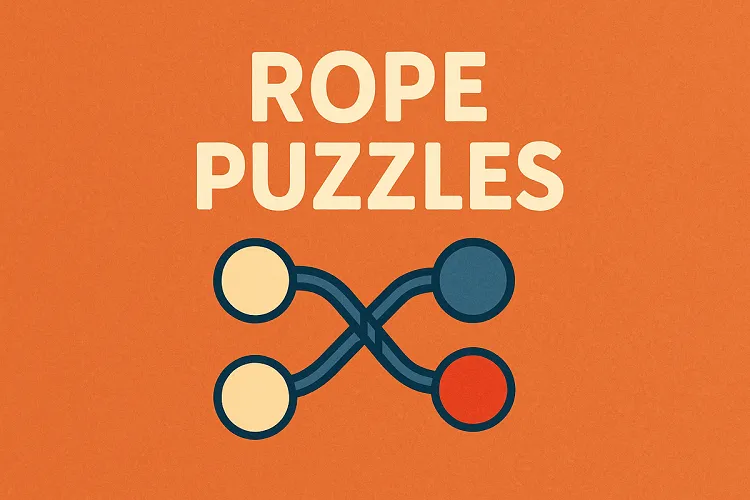Rope Games
Rope Puzzle Games — Flexible Thinking for Flexible Solutions

Rope puzzle games leverage the unique physics of flexible connectors — swinging pendulums, tension dynamics, cutting consequences, and gravity-influenced motion — to create challenges unlike rigid block or tile puzzles. Ropes behave organically, swaying and reacting to forces in ways that feel both intuitive (we understand rope physics from real life) and complex (predicting exact motion requires careful observation).
These games often center on strategic cutting: severing ropes at precise moments to release objects, trigger chain reactions, or guide elements to goals using gravity and momentum unleashed by well-timed cuts.
Why Rope Mechanics Create Unique Puzzles
Dynamic Physics — Unlike static puzzle pieces, ropes swing, stretch, and respond to forces dynamically. Each cut or interaction creates motion that continues evolving.
Timing Challenges — Rope puzzles frequently require precise timing. Cut too early or late, and objects swing wrong directions or miss targets entirely.
Irreversible Actions — Most rope games make cuts permanent. Once severed, ropes can't be reattached, making each cut a commitment requiring careful consideration.
Pendulum Prediction — Understanding swinging mechanics becomes essential. How far will this object swing after the rope cuts? Where will it be when it reaches the bottom of its arc?
Chain Reaction Potential — Cutting one rope often affects others through physics interactions, creating opportunities for clever cascading solutions.
Types of Rope Puzzle Games
Cut the Rope Variants — Strategic rope cutting to deliver objects to goals, avoid obstacles, or trigger specific outcomes through gravity and swinging.
Swing Mechanics — Using rope physics for character movement, swinging across gaps, or building momentum through pendulum motion.
Tension Puzzles — Challenges involving rope tension, supporting weights, or balancing forces where cutting order matters critically.
Rope Drawing — Games where you draw ropes or connections that then behave according to physics simulation to solve challenges.
Untangling — Logic puzzles requiring you to manipulate rope arrangements to eliminate knots or achieve specific configurations.
The Strategic Layer
Rope puzzle mastery requires understanding complex physics:
Pendulum Mechanics — Predicting swing arcs, momentum, and the exact position of swinging objects at any moment.
Gravity Interaction — Understanding how gravity affects suspended objects the instant rope tension releases.
Sequence Optimization — Determining optimal cutting order when multiple ropes interact through physics relationships.
Obstacle Navigation — Planning cuts so swinging objects avoid hazards while reaching targets.
Momentum Management — Sometimes you want objects to swing gently; other times maximum momentum is needed. Knowing which rope cuts create which outcomes separates novices from experts.
The Satisfaction of Perfect Cuts
Few puzzle moments feel as satisfying as a perfectly executed rope cut. You've analyzed the physics, predicted the swing trajectory, timed the cut precisely, and watched as the object follows exactly the path you calculated — swinging past obstacles, collecting bonuses, and landing exactly on target.
This satisfaction comes from:
- Physics prediction accuracy — Your mental model matched reality
- Timing precision — You executed at the exact right moment
- Visual elegance — Watching beautiful pendulum motion you created
- Strategic validation — Your plan worked perfectly
Educational Physics Learning
Rope puzzles teach genuine physics concepts:
Pendulum Behavior — Understanding period, amplitude, and energy in swinging systems Gravity Effects — Seeing acceleration and momentum from gravitational pull Tension Forces — Learning how ropes transmit forces and support weights Conservation of Momentum — Observing energy transfer as objects swing Trajectory Prediction — Developing intuition for ballistic and pendulum paths
This learning happens through play rather than instruction, making concepts stick through experience.
Perfect for Spatial Thinkers
Rope puzzles appeal to players who excel at:
- Spatial reasoning — Visualizing motion paths in 3D space
- Physics intuition — Understanding real-world mechanical behavior
- Timing precision — Executing actions at optimal moments
- Consequence prediction — Mentally simulating outcomes before acting
- Patience — Observing and planning rather than rushing
The Beauty of Realistic Simulation
Quality rope physics engines create mesmerizing motion. Watching ropes swing naturally, seeing realistic pendulum behavior, observing how objects react to gravity after cuts — these visual experiences engage both your problem-solving brain and your aesthetic appreciation.
Well-simulated rope physics feels right in a way that satisfies deeper than arbitrary puzzle rules. The motion follows natural laws you intrinsically understand, making solutions feel discovered rather than arbitrary.
Accessibility Through Familiarity
Everyone has experience with ropes, strings, or swinging objects. This familiarity makes rope puzzles immediately accessible:
Intuitive Understanding — You already know ropes swing when suspended, fall when cut Visual Learning — Watch what happens and adjust strategy accordingly Simple Controls — Usually just "tap to cut" or similar one-action mechanics Clear Feedback — Immediate visual results show whether your timing and placement worked
Challenge Scaling
Rope puzzles accommodate wide skill ranges:
Simple Levels — Single rope, obvious target, straightforward physics Intermediate — Multiple ropes, timing requirements, obstacle avoidance Advanced — Complex rope interactions, precision timing chains, multi-step sequences Expert — Minimal cut solutions, perfect collection challenges, speedrun optimization
Stress Relief Through Satisfying Physics
There's therapeutic value in rope puzzles:
- Focused attention on timing and physics prediction
- Satisfying motion watching pendulums swing naturally
- Low-pressure gameplay typically no harsh fail states
- Meditative observation studying physics before acting
- Visual pleasure from graceful swinging motion
Discover Rope Puzzle Games
Explore our collection of rope puzzle games and master the physics of flexible mechanics. Whether you're cutting ropes to deliver objects, swinging across gaps, managing tension and support, drawing physical connections, or untangling complex arrangements, these games prove that sometimes the most engaging puzzles are held together by the thinnest threads.
Observe the swing, predict the motion, time your cut, and watch physics do the rest. That's the elegant challenge of rope puzzle games — where flexible thinking solves flexible problems.


